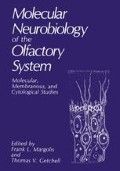Abstract
The olfactory system displays a dramatically sensitive and selective recognition system for odorants. Animals can detect and discriminate thousands of odorants, some at ambient concentrations as low as one part per trillion (1 ppt). While numerous theories have been advanced to explain this sensitivity and selectivity (Amoore, 1982), remarkably few direct experimental data support any specific molecular mechanism. It is not known whether the nose possesses thousands of distinct olfactory receptors or whether the influence of odorants on a small population of receptors can account for our ability to discriminate among large numbers of odorants.
Access this chapter
Tax calculation will be finalised at checkout
Purchases are for personal use only
Preview
Unable to display preview. Download preview PDF.
References
Amoore, J. M., 1982, Odor theory and odor classification, in: Fragrance Chemistry: The Science of the Sense of Smell (E.T. Theimer, ed.), pp. 27–76, Academic, New York.
Anholt, R. R. H., Aebi, U., and Snyder, S. H., 1986, A partially purified preparation of isolated chemosensory cilia from the olfactory epithelium of the bullfrog, Rana catesbeiana, J. Neurosci. 6: 1962–1969.
Anholt, R. R. H., Mumby, S. M., Stoffers, D. A., Girard, P. R., Kuo, J. F., and Snyder, S. H., 1987, Transduction proteins of olfactory receptor cells: Identification of guanine nucleotide binding proteins and protein kinase C, Biochemistry 26: 788–795.
Bignetti, E., Cavaggioni, A., Pelosi, P., Persaud, K. C., Sorbi, R. T., and Tirindelli, R., 1985, Purification and characterization of an odorant-binding protein from cow nasal tissue, Eur. J. Biochem. 149: 227–231.
Cockcroft, S., and Gomperts, B. D., 1985, Role of guanine nucleotide binding protein in the activation of polyphosphoinositide phosphodiesterase, Nature (Lond.) 314: 534–536.
Getchell, T. V., Margolis, F. L., and Getchell, M. L., 1984, Perireceptor and receptor events in vertebrate olfaction, Prog. Neurobiol. 23: 317–345.
Gilman, A. G., 1984, G proteins and dual control of adenylate cyclase, Cell 36: 577–579.
Huff, R. M., Axton, J. M., and Neer, E. J., 1985, Physical and immunological characterization of a guanine nucleotide-binding protein purified from bovine cerebral cortex, J. Biol. Chem. 260: 10864–10871.
Kurihara, K., and Koyama, N., 1972, High activity of adenyl cyclase in olfactory and gustatory organs, Biochem. Biophys. Res. Commun. 48: 30–33.
Lancet, D., 1986, Vertebrate olfactory reception, Annu. Rev. Neurosci. 9: 329–355.
Maga, J. A., and Sizer, C. E., 1973, Pyrazines in foods, CRC Rev. Food Technol. 16: 1–48.
Mitchell, P., 1967, Translocations through natural membranes, Adv. Enzymol. 29: 33–87.
Mumby, S. M., Kahn, R. A., Manning, D. R., and Gilman, A. G., 1986, Antisera of designated specificity for subunits of guanine nucleotide-binding regulatory proteins, Proc. Natl. Acad. Sci. USA 83: 265–269.
Pace, U., Hanski, E., Salomon, Y., and Lancet, D., 1985, Odorant-sensitive adenylate cyclase may mediate olfactory reception, Nature (Lond.) 316: 255–258.
Pelosi, P., and Pisanelli, A. M., 1981, Binding of [3H]-2-isobutyl-3-methoxypyrazine to cow olfactory mucosa, Chem. Senses 6: 77–85.
Pelosi, P., Baldaccini, N. E., and Pisanelli, A. M.,1982, Identification of a specific olfactory receptor for 2-isobutyl-3-methoxypyrazine, Biochem. J. 201: 245–248.
Pevsner, J., Trifiletti, R. R., Strittmatter, S. M., and Snyder, S. H., 1985, Isolation and characterization of an olfactory receptor protein for odorant pyrazines, Proc. Natl. Acad. Sci. USA 82: 3050–3054.
Pevsner, J., Sklar, P. B., and Snyder, S. H., 1986, Odorant binding protein: Localization to nasal glands and secretions, Proc. Natl. Acad. Sci. USA 83: 4942–4946.
Pfaffinger, P. J., Martin, J. M., Hunter, D. D., Nathanson, N. M., and Hille, B., 1985, GTP-binding proteins couple cardiac muscarinic receptors to a K channel, Nature (Lond.) 317: 536–538.
Schramm, M., and Selinger, Z., 1984, Message transmission: Receptor controlled adenylate cyclase system, Science 225: 1350–1356.
Senf, W., Menco, B. P. M., Punter, P. H., and Duyvesteyn, P., 1980, Determination of odor affinities based on the dose-response relationships of the frog’s electro-olfactogram, Experentia 36: 213–215.
Sklar, P. B., Anholt, R. R. H., and Snyder, S. H., 1986, The odorant-sensitive adenylate cyclase of olfactory receptor cells: Differential stimulation by distinct classes of odorants, J. Biol. Chem. 26: 15538–15543.
Snyder, S. H., 1984, Drug and neurotransmitter receptors in the brain, Science 224: 22–31.
Stryer, L., 1983, Transducin and the cyclic GMP phosphodiesterase: Amplifer proteins in vision, Cold Spring Harbor Symp. Quant. Biol. 47: 841–852.
Topazzini, A., Pelosi, P., Pasqualetto, P. L. and Baldaccini, N. E., 1985, Specificity of a pyrazine binding protein from cow olfactory mucosa, Chem. Senses 10: 45–49.
van Veen, T., Ostholm, T., Gierschik, P., Spiegel, A., Somers, R., Korf, H. W., and Klein, D. C., 1986, a- Transdusin immunoreactivity in retinae and sensory pineal organs of adult vertebrates, Proc. Natl. Acad. Sci. USA 83: 912–916.
Widdicombe, J. G., and Wells, U. M., 1982, Airway secretions, in: The Nose—Upper Airway Physiology and the Atmospheric Environment (D.F. Proctor and I.B. Andersen, eds.), pp. 215–244, Elsevier, New York.
Worley, P. F., Baraban, J. M., Van Dop, C., Neer, E. J., and Snyder, S. H., 1986, G0, a guanine nucleotidebinding protein: Immunohistochemical localization in rat brain resembles distribution of second messengers, Proc. Natl. Acad. Sci. USA 83: 4561–4565.
Author information
Authors and Affiliations
Editor information
Editors and Affiliations
Rights and permissions
Copyright information
© 1988 Plenum Press, New York
About this chapter
Cite this chapter
Snyder, S.H., Sklar, P.B., Pevsner, J. (1988). Olfactory Receptor Mechanisms. In: Margolis, F.L., Getchell, T.V. (eds) Molecular Neurobiology of the Olfactory System. Springer, Boston, MA. https://doi.org/10.1007/978-1-4613-0989-5_1
Download citation
DOI: https://doi.org/10.1007/978-1-4613-0989-5_1
Publisher Name: Springer, Boston, MA
Print ISBN: 978-1-4612-8280-8
Online ISBN: 978-1-4613-0989-5
eBook Packages: Springer Book Archive

